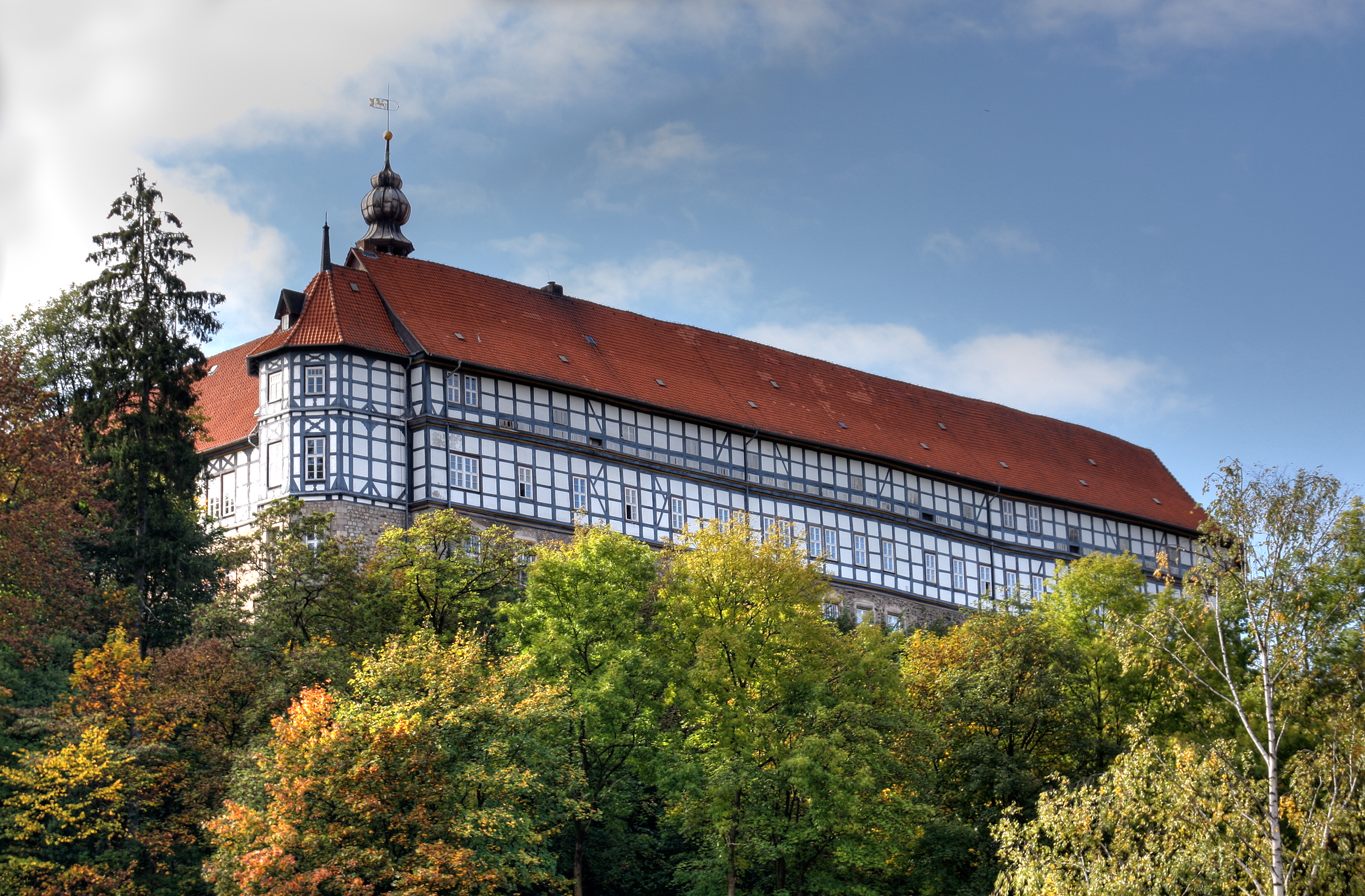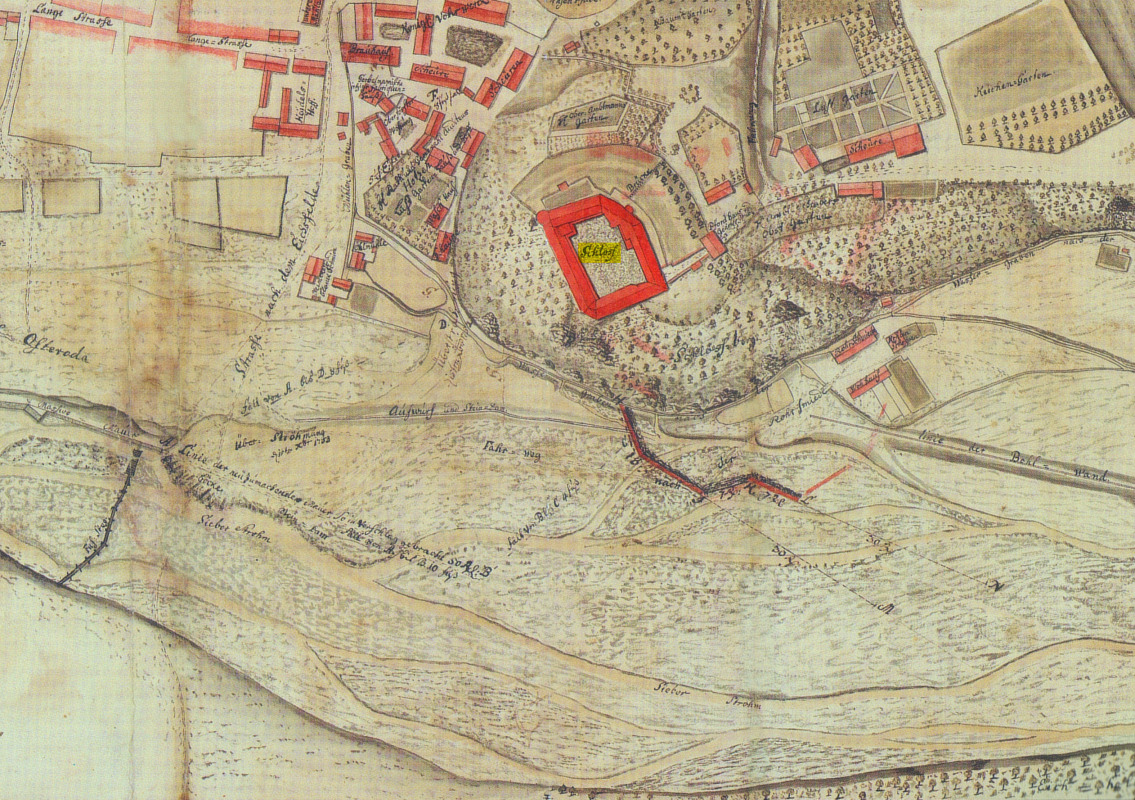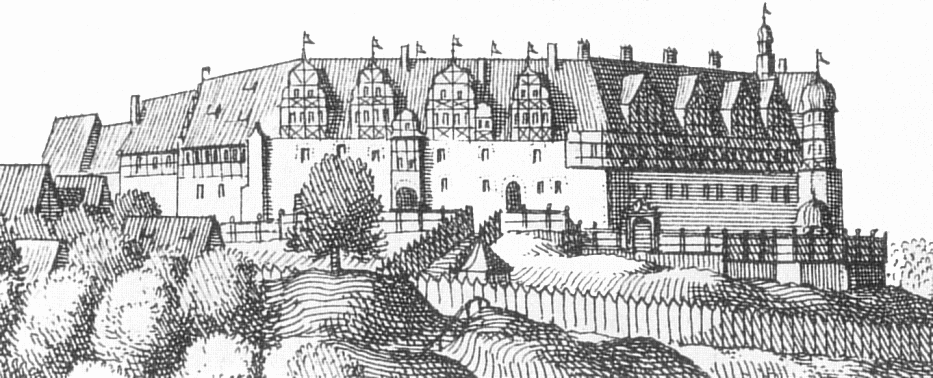Schloss Herzberg on:
[Wikipedia]
[Google]
[Amazon]

 Herzberg Castle (german: Schloss Herzberg) is a German ''
Herzberg Castle (german: Schloss Herzberg) is a German ''

 The present castle is an enclosed four-winged building with a rectangular courtyard (40 x 58 m) and was rebuilt after a serious fire in November 1510. Since the new castle was completed in 1528 its basements have been made of
The present castle is an enclosed four-winged building with a rectangular courtyard (40 x 58 m) and was rebuilt after a serious fire in November 1510. Since the new castle was completed in 1528 its basements have been made of
 Originally the ''schloss'' was a medieval castle that was based on a hunting lodge built on the spot between 1024 and 1029. The castle was probably built at the behest of King, later Emperor,
Originally the ''schloss'' was a medieval castle that was based on a hunting lodge built on the spot between 1024 and 1029. The castle was probably built at the behest of King, later Emperor, 
 In 1290 the castle became the residence of the Welf line of Brunswick- Grubenhagen, which was formed around this time. From 1486 the dukes of the Principality of Grubenhagen lived here until they died out in 1596. Thereafter the estate was transferred to the Welf line of Brunswick- Lüneburg.
There was a major fire at the castle in 1510. The lord of the castle, Duke Philip I, his wife, Catharine, and their son, Philip, were rescued at the last minute from the rapidly engulfing flames. The duke's shield bearer and the duchess's chambermaid died in the fire.
Duke
In 1290 the castle became the residence of the Welf line of Brunswick- Grubenhagen, which was formed around this time. From 1486 the dukes of the Principality of Grubenhagen lived here until they died out in 1596. Thereafter the estate was transferred to the Welf line of Brunswick- Lüneburg.
There was a major fire at the castle in 1510. The lord of the castle, Duke Philip I, his wife, Catharine, and their son, Philip, were rescued at the last minute from the rapidly engulfing flames. The duke's shield bearer and the duchess's chambermaid died in the fire.
Duke
Museum Schloss Herzberg Castle Museum
of Herzberg Castle at karstwanderweg.de {{Authority control 12th-century fortifications Castles in the Harz

 Herzberg Castle (german: Schloss Herzberg) is a German ''
Herzberg Castle (german: Schloss Herzberg) is a German ''schloss
''Schloss'' (; pl. ''Schlösser''), formerly written ''Schloß'', is the German term for a building similar to a château, palace, or manor house.
Related terms appear in several Germanic languages. In the Scandinavian languages, the cognate ...
'' in Herzberg am Harz
Herzberg am Harz is a town in the Göttingen district of Lower Saxony, Germany.
Geography
Herzberg is situated on the southwestern rim of the Harz mountain range and the Harz National Park. Natural monuments in the surrounding area include the ...
in the district of Göttingen
Göttingen (, , ; nds, Chöttingen) is a college town, university city in Lower Saxony, central Germany, the Capital (political), capital of Göttingen (district), the eponymous district. The River Leine runs through it. At the end of 2019, t ...
in the state of Lower Saxony
Lower Saxony (german: Niedersachsen ; nds, Neddersassen; stq, Läichsaksen) is a German state (') in northwestern Germany. It is the second-largest state by land area, with , and fourth-largest in population (8 million in 2021) among the 16 ...
. The present-day, quadrangular building has its origins in the 11th century as a medieval
In the history of Europe, the Middle Ages or medieval period lasted approximately from the late 5th to the late 15th centuries, similar to the Post-classical, post-classical period of World history (field), global history. It began with t ...
''castle
A castle is a type of fortified structure built during the Middle Ages predominantly by the nobility or royalty and by military orders. Scholars debate the scope of the word ''castle'', but usually consider it to be the private fortified r ...
''. After a fire in 1510 it was rebuilt as a ''schloss'' and is one of the few in Lower Saxony that was constructed as a timber-framed
Timber framing (german: Holzfachwerk) and "post-and-beam" construction are traditional methods of building with heavy timbers, creating structures using squared-off and carefully fitted and joined timbers with joints secured by large wooden ...
building. Because it belonged to the House of Welf
The House of Welf (also Guelf or Guelph) is a European dynasty that has included many German and British monarchs from the 11th to 20th century and Emperor Ivan VI of Russia in the 18th century. The originally Franconia, Franconian family from ...
for 700 years it is also known as the Welf Castle of Herzberg (''Welfenschloss Herzberg'').
Geography
Herzberg Castle stands on a wooded eminence () immediately above and west of the centre of the town of Herzberg am Harz, which lies on the southwestern edge of theHarz Mountains
The Harz () is a highland area in northern Germany. It has the highest elevations for that region, and its rugged terrain extends across parts of Lower Saxony, Saxony-Anhalt, and Thuringia. The name ''Harz'' derives from the Middle High German ...
. A stretch of the River Sieber runs past the castle to the north.
Architecture

 The present castle is an enclosed four-winged building with a rectangular courtyard (40 x 58 m) and was rebuilt after a serious fire in November 1510. Since the new castle was completed in 1528 its basements have been made of
The present castle is an enclosed four-winged building with a rectangular courtyard (40 x 58 m) and was rebuilt after a serious fire in November 1510. Since the new castle was completed in 1528 its basements have been made of sandstone
Sandstone is a clastic sedimentary rock composed mainly of sand-sized (0.0625 to 2 mm) silicate grains. Sandstones comprise about 20–25% of all sedimentary rocks.
Most sandstone is composed of quartz or feldspar (both silicates) ...
. One wing has an upper storey of stone, while the upper floors of the other three wings have been constructed using timber-framing. Its access through a gate tower and adjoining barbican
A barbican (from fro, barbacane) is a fortified outpost or fortified gateway, such as at an outer fortifications, defense perimeter of a city or castle, or any tower situated over a gate or bridge which was used for defensive purposes.
Europe ...
has been retained. The old castle and the inner courtyard of the new one are entered after passing through the two-story gatehouse
A gatehouse is a type of fortified gateway, an entry control point building, enclosing or accompanying a gateway for a town, religious house, castle, manor house, or other fortification building of importance. Gatehouses are typically the mos ...
. The castle tower, known as the Clock Tower (''Uhrturm''), was built in the eastern corner. Its three upper storeys are made of timber.
History
 Originally the ''schloss'' was a medieval castle that was based on a hunting lodge built on the spot between 1024 and 1029. The castle was probably built at the behest of King, later Emperor,
Originally the ''schloss'' was a medieval castle that was based on a hunting lodge built on the spot between 1024 and 1029. The castle was probably built at the behest of King, later Emperor, Lothair III
Lothair III, sometimes numbered Lothair II and also known as Lothair of Supplinburg (1075 – 4 December 1137), was Holy Roman Emperor from 1133 until his death. He was appointed List of rulers of Saxony, Duke of Saxony in 1106 and elected List o ...
, known as Lothair of Süpplingenburg
Süpplingenburg is a Municipalities of Germany, municipality in the district of Helmstedt (district), Helmstedt, Lower Saxony, Germany. It is part of the collective municipality (''Samtgemeinde'') of Nord-Elm.
The village developed next to a 10th ...
.
In 1144, Herzberg Castle was given to the von Göttingen family of ministeriales from Bavaria by the House of Welf
The House of Welf (also Guelf or Guelph) is a European dynasty that has included many German and British monarchs from the 11th to 20th century and Emperor Ivan VI of Russia in the 18th century. The originally Franconia, Franconian family from ...
, who charged them with maintaining the castle and its surroundings. Previously, Count Hermann of Lutterberge had lived here, but he died in 1143 without any heirs who could inherit the fiefdom. The castle was first recorded in 1143 and, in 1158, it finally became a Welf allodial possession In the law of the Middle Ages and early Modern Period and especially within the Holy Roman Empire, an allod (Old Low Franconian ''allōd'' ‘fully owned estate’, from ''all'' ‘full, entire’ and ''ōd'' ‘estate’, Medieval Latin ''allodium ...
as the result of an exchange of property between Frederick Barbarossa
Frederick Barbarossa (December 1122 – 10 June 1190), also known as Frederick I (german: link=no, Friedrich I, it, Federico I), was the Holy Roman Emperor from 1155 until his death 35 years later. He was elected King of Germany in Frankfurt on ...
and the Welf, Henry the Lion
Henry the Lion (german: Heinrich der Löwe; 1129/1131 – 6 August 1195) was a member of the Welf dynasty who ruled as the duke of Saxony and Bavaria from 1142 and 1156, respectively, until 1180.
Henry was one of the most powerful German p ...
. Henry the Lion gave up estates inherited through his first wife, Clementia of Zähringen
Clementia of Zähringen (died 1175), was a daughter of Conrad I, Duke of Zähringen and his wife Clementia of Namur. By her first marriage, Clementia was Duchess of Bavaria and Saxony. By her second marriage she was Countess of Savoy.
Duchess of ...
in Swabia
Swabia ; german: Schwaben , colloquially ''Schwabenland'' or ''Ländle''; archaic English also Suabia or Svebia is a cultural, historic and linguistic region in southwestern Germany.
The name is ultimately derived from the medieval Duchy of ...
. Since then the castle has been in Welf hands uninterruptedly for 708 years until the demise of the Kingdom of Hanover
The Kingdom of Hanover (german: Königreich Hannover) was established in October 1814 by the Congress of Vienna, with the restoration of George III to his Hanoverian territories after the Napoleonic era. It succeeded the former Electorate of Han ...
in 1866.
Empress Maria of Brabant, widow of Emperor Otto IV, made out a deed at the ''Hertsberg'' in 1218, thus the castle was an imperial residence for a short while. In 1279 the castle served as the residence for the widow of Duke Albert the Great
Albertus Magnus (c. 1200 – 15 November 1280), also known as Saint Albert the Great or Albert of Cologne, was a German Dominican friar, philosopher, scientist, and bishop. Later canonised as a Catholic saint, he was known during his life ...
. From 1337 to 1714 the castle was a ducal residence almost continuously.

 In 1290 the castle became the residence of the Welf line of Brunswick- Grubenhagen, which was formed around this time. From 1486 the dukes of the Principality of Grubenhagen lived here until they died out in 1596. Thereafter the estate was transferred to the Welf line of Brunswick- Lüneburg.
There was a major fire at the castle in 1510. The lord of the castle, Duke Philip I, his wife, Catharine, and their son, Philip, were rescued at the last minute from the rapidly engulfing flames. The duke's shield bearer and the duchess's chambermaid died in the fire.
Duke
In 1290 the castle became the residence of the Welf line of Brunswick- Grubenhagen, which was formed around this time. From 1486 the dukes of the Principality of Grubenhagen lived here until they died out in 1596. Thereafter the estate was transferred to the Welf line of Brunswick- Lüneburg.
There was a major fire at the castle in 1510. The lord of the castle, Duke Philip I, his wife, Catharine, and their son, Philip, were rescued at the last minute from the rapidly engulfing flames. The duke's shield bearer and the duchess's chambermaid died in the fire.
Duke George
George may refer to:
People
* George (given name)
* George (surname)
* George (singer), American-Canadian singer George Nozuka, known by the mononym George
* George Washington, First President of the United States
* George W. Bush, 43rd Presiden ...
of Brunswick and Lüneburg lived in the castle until 1635 with his wife, the Landgravine Anne Eleanor of Hesse-Darmstadt. In 1629, the first Elector of Hanover was born here, Ernest Augustus, Duke of Brunswick-Lüneburg.
In 1714 the ''schloss'' was given up as a residence and from 1882 it was the seat of the district court of Herzberg. In 1900 a museum was established in the castle. Although the castle had survived largely undamaged by fire over the centuries, it suffered severe damage at the end of the Second World War
World War II or the Second World War, often abbreviated as WWII or WW2, was a world war that lasted from 1939 to 1945. It involved the vast majority of the world's countries—including all of the great powers—forming two opposin ...
, which has since been repaired. On the night of 4 April 1945, there was a mighty explosion at a nearby ammunition dump, where 40,000 kg of explosives
An explosive (or explosive material) is a reactive substance that contains a great amount of potential energy that can produce an explosion if released suddenly, usually accompanied by the production of light, heat, sound, and pressure. An expl ...
and 8,000 mines had been stored. This blew the roof off the castle and, in the wake of the explosion, the museum was destroyed and probably looted. In 1947, further damage was caused when some nearby military bunkers were blown up.
Today the castle houses a small cultural centre with a restaurant, a museum and the great hall
A great hall is the main room of a royal palace, castle or a large manor house or hall house in the Middle Ages, and continued to be built in the country houses of the 16th and early 17th centuries, although by then the family used the great ...
, which is used for various cultural events. The museum portrays the history of the forestry industry in the Harz, the castle's history and that of the Welfs. Other exhibition areas present the history of Herzberg arms manufacture as well as the work of Herzberg organ maker Johann Andreas Engelhardt. In part of the permanent exhibition there is a facsimile of the Gospels of Henry the Lion, a masterpiece of Romanesque book illumination of the 12th century containing the four Gospel
Gospel originally meant the Christian message ("the gospel"), but in the 2nd century it came to be used also for the books in which the message was set out. In this sense a gospel can be defined as a loose-knit, episodic narrative of the words an ...
accounts.
Sources
* Ernst Andreas Friedrich: ''Wenn Steine reden könnten.'' Bd 4. Landbuch-Verlag, Hannover 1998, * Hans Adolf Schultz: ''Burgen und Schlösser des Braunschweiger Landes'', Braunschweig 1980, * Phillip Julius Rehtmeier: ''Historische Beschreibung'' S. 311, Braunschweig 1722 * Jürgen Wilke, ''Die Geschichte des Wappens der Stadt Herzberg/Harz'' S. 1-33 + Literaturverzeichnis, Göttingen 1998 * Wolfenbüttel Nds.StA. 1 Urk. 2 * Die Chronik Arnolds von Lübeck. Nach der Ausgabe der Monumenta Germaniae, übersetzt von Dr. J.C.M. Laurent, Berlin 1853External links
Museum Schloss Herzberg Castle Museum
of Herzberg Castle at karstwanderweg.de {{Authority control 12th-century fortifications Castles in the Harz
Castle
A castle is a type of fortified structure built during the Middle Ages predominantly by the nobility or royalty and by military orders. Scholars debate the scope of the word ''castle'', but usually consider it to be the private fortified r ...
Renaissance architecture in Germany
Museums in Lower Saxony
Lothair III, Holy Roman Emperor